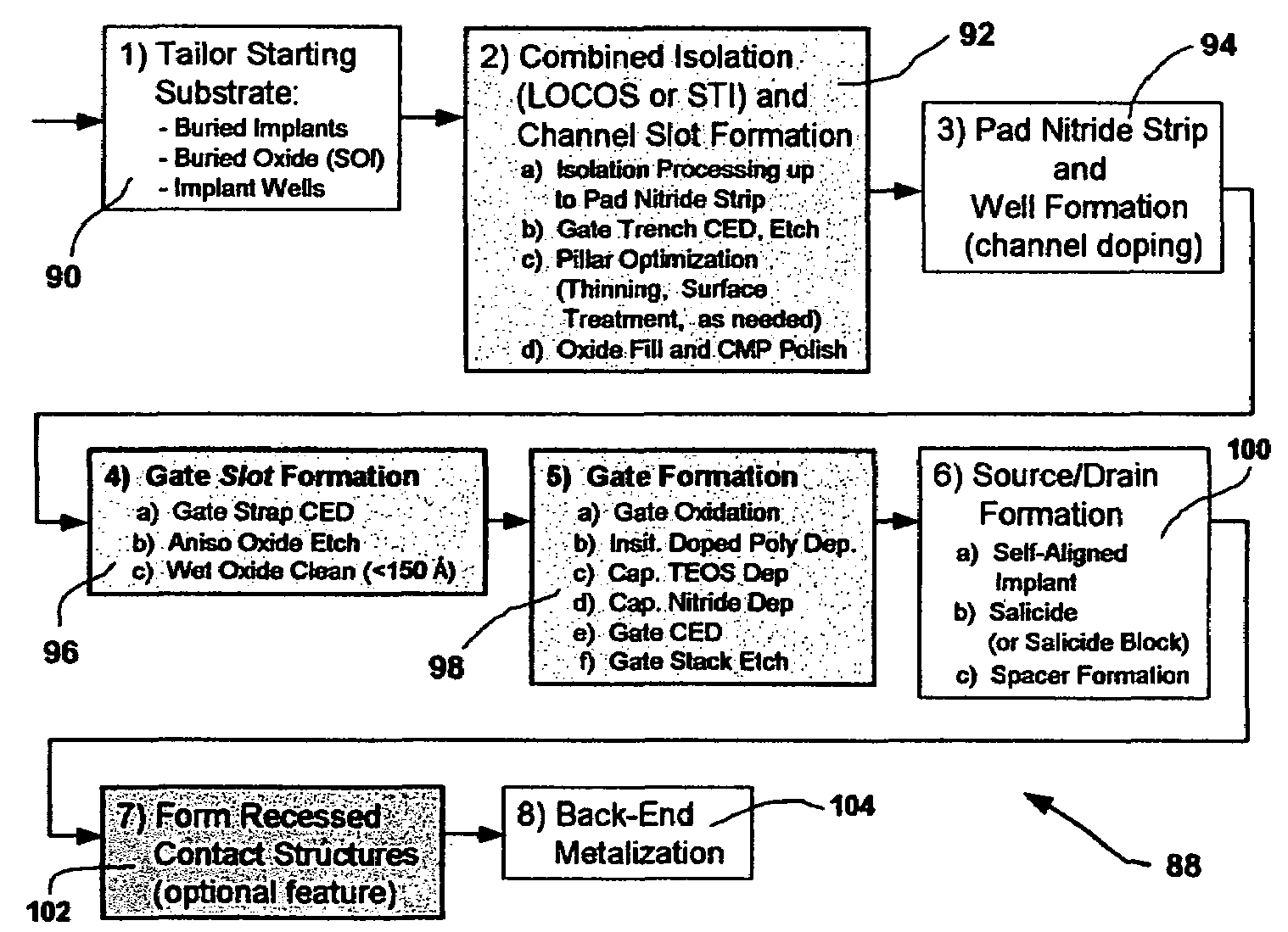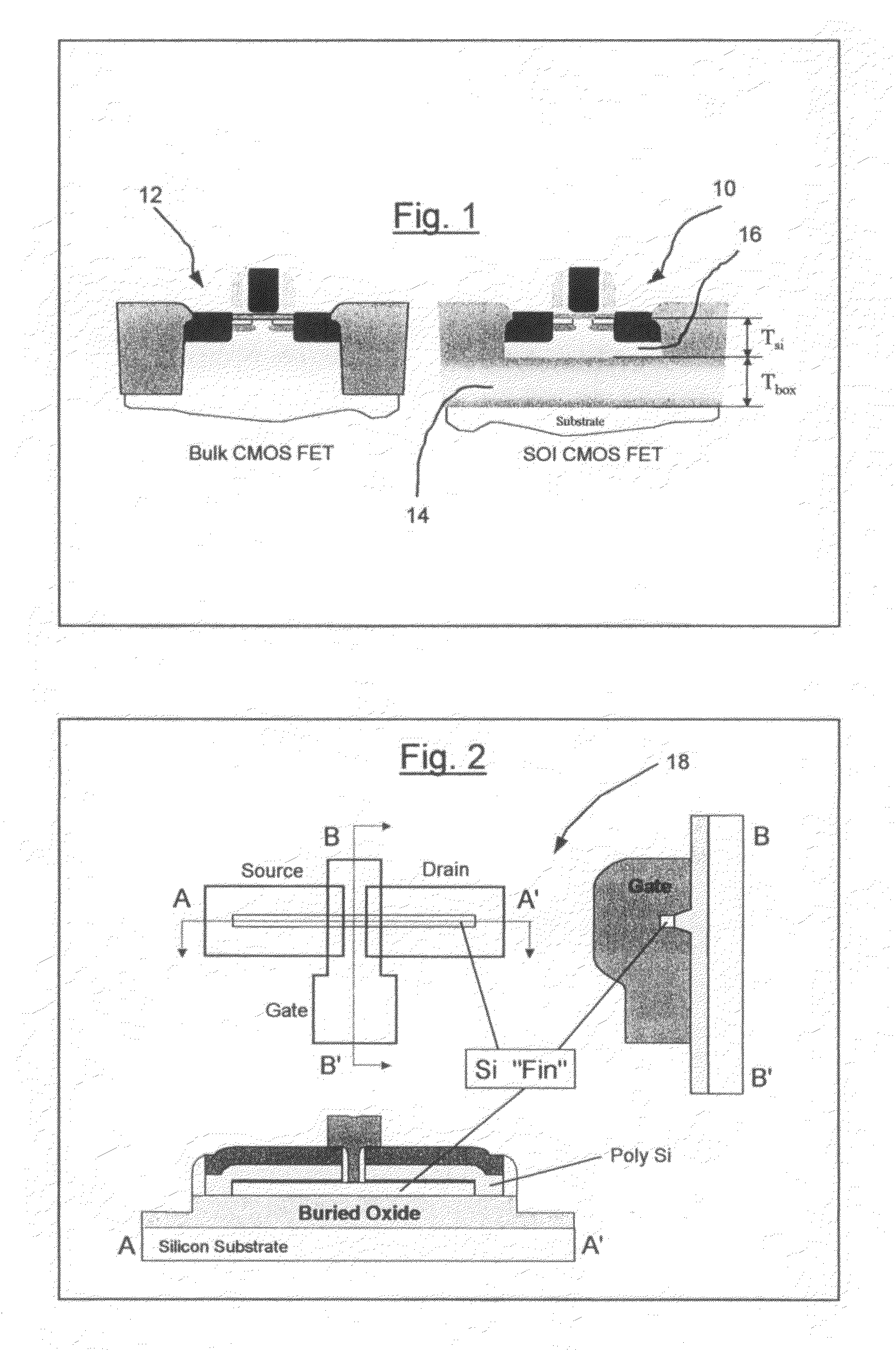Fully-depleted castellated gate MOSFET device and method of manufacture thereof
a castellated gate and mosfet technology, applied in the field of field effect transistors, can solve the problems of reducing the power consumption of digital functions, and reducing the number of significant problems
- Summary
- Abstract
- Description
- Claims
- Application Information
AI Technical Summary
Benefits of technology
Problems solved by technology
Method used
Image
Examples
embodiment 72
[0089]The contacts 66 to the source and drain structures 24, 26 may be coincident with the upper silicon surface, or contacts 67 (as shown in FIG. 4A) may penetrate into the uppermost impurity layer depending on the desired device electrical characteristics. For example, surface contacts 66 could result in higher series resistance, which would be beneficial in enhancing ESD characteristics. In the particular example of FIGS. 3 and 3A, the contact masks 70 are laid-out in such a way as to be directly in-line with the conductive channels 22. This approach should provide the least device series resistance, thus improving device performance. Furthermore, it should be understood that additional process steps can be added to the overall fabrication sequence to shut-down the bottom gate. Examples are illustrated in the case of a dual-gate embodiment 72 illustrated in FIGS. 4 and 4A, including the addition of a highly doped “global” buried layer 74, preferably p-type for an NMOS device, and...
embodiment 78
[0090]FIGS. 5 and 5A illustrate an NMOS device embodiment 78 of the disclosed device invention using a silicon-on-insulator (SOI) starting substrate 80. Note that the device mask layout remains substantially the same as the case of the device 20 with the bulk starting wafer 21 shown in FIGS. 3-3A. Substantially similar to the bulk silicon substrate device 20, the device 78 includes a plurality of thin silicon channel elements 22 that span the distance between a source region 24 and a drain region 26. In the SOI wafer case of the device 78, the device's gate slots 82 can be etched to the same depth as the STI islands 54, 56, that is all the way to the buried oxide 75. However, there are advantages to leaving a common silicon connection in the form of the substrate 21 of FIGS. 3 and 3A at the bottom, thus enabling the use of body contacts which can be employed to eliminate device snapback problems as well as provide a path of higher thermal conductivity with which to dissipate heat.
[0...
second embodiment
[0128]In this second method embodiment, penetration of the source and drain implant 24, 26 into the polysilicon 150 is no longer a concern. However, the nitride cap layer 154 provides 50% higher stopping power than polysilicon, thus extending the depth to which the source and drains 24, 26, and therefore the channel slots 22, can be fabricated. The purpose of the polysilicon 150 as the bottom stack layer is so that any spacers or stringers that are formed can be removed utilizing an ashing step. Thus, an advantage of this second embodiment is that the entire dummy gate stack 149 is used to self-align the source and drain implants 24, 26, which provides the opportunity to increase the device drive current with higher aspect ratio gate trenches.
[0129]The thickness of the total gate stack 149 must provide the net stopping power to block the implant that forms the bottom portions 62, 64 of the lower source and drain structure 24, 26 (p-type in the case of an NMOS device) from penetratin...
PUM
 Login to View More
Login to View More Abstract
Description
Claims
Application Information
 Login to View More
Login to View More - R&D
- Intellectual Property
- Life Sciences
- Materials
- Tech Scout
- Unparalleled Data Quality
- Higher Quality Content
- 60% Fewer Hallucinations
Browse by: Latest US Patents, China's latest patents, Technical Efficacy Thesaurus, Application Domain, Technology Topic, Popular Technical Reports.
© 2025 PatSnap. All rights reserved.Legal|Privacy policy|Modern Slavery Act Transparency Statement|Sitemap|About US| Contact US: help@patsnap.com



